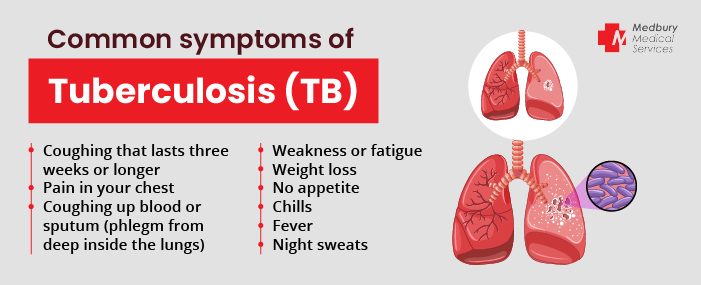
Tuberculosis: The Complete Guide to Symptoms, Causes, Treatments, and Prevention
Tuberculosis (TB) refers to the lung infection caused by bacteria, mycobacteria, called Mycobacterium tuberculosis. TB was first documented in 1882 by Dr. Robert Koch, a German scientist. Today, TB affects one-third of the world’s population, according to the World Health Organization (WHO). Around 10 million people die yearly from TB or complications from other illnesses with TB, such as AIDS and diabetes.
We will cover everything you need to know about tuberculosis, symptoms of tuberculosis and how to avoid contracting it, and how to seek help if you have it.
What is Tuberculosis?
The Centers for Disease Control and Prevention (CDC) says that tuberculosis is an infectious disease that affects the lungs. It can also affect other body parts, such as the kidneys and spine. The bacteria known as mycobacteria cause it; TB is treatable and curable, but it can be life-threatening if left untreated. The most at risk are individuals who:
- Were born or spent time in countries where there is a lot of tuberculosis infection.
- Live or work in homeless shelters, prisons, hospitals, and prisons.
- Are living with HIV.
- Patients on intravenous medication.
- Drink alcohol or smoke a lot.
- Have diabetes.
- When they were babies or young children, they contracted TB.
Statistics about tuberculosis
In 2020, WHO estimates 1.5 million people will die from TB (including 214 000 people with HIV). Globally, TB is the thirteenth leading cause of death and the second leading infectious killer after COVID-19.
Every country in the world has TB. The World Health Organization identified 44% of new TB cases in the South-East Asian Region in 2020, 25% in Africa, and 18% in the Western Pacific.
Eighty-six percent of new TB cases occurring in 2020 occurred in the 30 countries with the highest TB burden. Most new TB cases originated in eight countries: India, China, Indonesia, the Philippines, Pakistan, Nigeria, Bangladesh, and South Africa.
Symptoms Of Tuberculosis (TB)
- Coughing that lasts three weeks or longer
- Pain in your chest
- Coughing up blood or sputum (phlegm from deep inside the lungs)
- Weakness or fatigue
- Weight loss
- No appetite
- Chills
- Fever
- Night sweats

If you have developed symptoms of tuberculosis in your lungs or throat, such as a persistent cough that lasts over three weeks, your doctor should screen you for TB disease. It is important to note that many people with tuberculosis experience no symptoms of infection at all; they are often unaware they have it until an advanced stage when it is not treatable anymore. Therefore, patients must undergo regular screenings for possible tuberculosis bacteria in their systems.
Tuberculosis: How they spread
A person with tuberculosis can transmit the disease through infected droplets that a person with tuberculosis coughs into your airway. You cannot get tuberculosis from a toilet seat, water faucet, elevator buttons, or other objects. It is also impossible to get tuberculosis from drinking milk or eating food prepared in a kitchen where someone has TB.
Types of tuberculosis
It is vital to understand which type you have to receive proper treatment. Two main types of tuberculosis can infect the body:
- Active TB
- Latent TB
Active tuberculosis is contagious, while latent TB is not. The two types differ in their symptoms, the treatment they require, and how they affect those who have them.
Active Tuberculosis
Active tuberculosis is more common than latent tuberculosis and is a more severe condition. It occurs when the disease progresses to an advanced stage and spreads throughout the body, causing many symptoms and being contagious. Active TB patients pose health risks to others. Someone with active TB can transmit it to anyone exposed to the individual for extended periods — even if that person does not have symptoms of the disease.
Latent tuberculosis
Latent TB is much less severe than active tuberculosis because the bacteria that cause it have not reached an advanced stage. However, it is still important to treat because it could progress into active TB. Someone with latent TB has dormant bacteria in the person’s system and will test positive for tuberculosis but show no symptoms. Latent TB doesn’t make someone sick, but someone can still spread it to others through coughing or sneezing.
How to diagnose TB in the lab?
There are two types of TB tests to take the TB skin test and the TB blood test:
Skin test for TB
It is a test performed by injecting a small amount of fluid (called tuberculin) into the skin on the lower part of the arm. A person given the tuberculin skin test must return within two to three days to have a trained health care worker look for a reaction on the arm.
If there is no swelling or redness, then it is likely that the TB bacteria do not infect you. When a person has an active TB infection, the skin becomes raised or bumpy in appearance. Additional tests are necessary to determine if the person has a latent TB infection.
TB Blood Test
A TB blood test called an interferon-gamma release assay (IGRA) looks for an immune response to the bacteria that causes the disease by drawing blood from a vein for the test.
TB may be latent or active based on the test results. Positive results show evidence of tuberculosis bacteria. Negative results show the person’s health is unaffected. Health providers need additional tests to determine if the person has latent TB infection or active TB infection.
Related: All you need to know about the Kidney function test
How Do You Start Your TB Treatment?
TB treatment involves taking several drugs over at least 6 to 9 months. The type of drugs and length of treatment depends on several factors, including the person’s age, overall health, and how long the TB bacteria have been present in the body. TB treatment is usually successful if the patient finishes it as directed.
Then, you will likely start on four antibiotics: isoniazid, rifampin (Rifadin), ethambutol (Myambutol), and pyrazinamide (PZA). It is important to follow your doctor’s directions and take all medications as prescribed.
If you are infected but not sick, you will probably take the medicines for 6 to 12 months.
If you have active TB, you might need to take the medicines for 6 to 24 months.
You could get better faster if you keep taking your medication, even if you feel better after a few weeks or months. Stopping soon could allow some TB bacteria to survive and cause your TB to come back worse than before.
If you do not take your drugs, the tuberculosis bacteria may become resistant to them — so that if you need those drugs, later on, they may not work as well for you. You could spread drug-resistant TB to others, too.
Related: Everything you need to know about the Lipid profile test
Is there a tuberculosis vaccine?
Yes. The TB vaccine, called Bacille Calmette-Guérin (BCG), is used in many countries with high rates of TB to prevent childhood tuberculous meningitis and miliary tuberculosis.
Tuberculosis prevention
- Avoid crowded places and people who cough a lot or have prolonged colds. In places where tuberculosis is prevalent, sit in areas with adequate ventilation.
- It is necessary to maintain proper hygiene. Scrub your hands frequently and keep cuts covered until they heal completely.
- When working in healthcare, wear personal protection equipment (PPE) when dealing with patients known to have tuberculosis.
- If you are traveling outside of your home country, ensure you receive all necessary vaccinations before you leave. And if you live in an area where tuberculosis is prevalent, see your doctor regularly for checkups and screenings.
Get screened against tuberculosis by booking an appointment with us by calling these numbers: 09027331921, 09070366241, or 700-6332879 to book a tuberculosis screening test with Medbury or by visiting our life check center.
